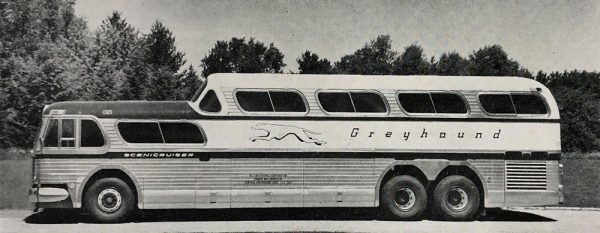
The GMC PD-4501 Scenicruiser, manufactured by General Motors (GM) for Greyhound Lines, Inc., was a three-axle monocoque two-level coach that Greyhound used from July 1954 into the mid-1970s. 1001 were made between 1954 and 1956.
The Scenicruiser became an icon of the American way of life due to its presence throughout the United States in cities and along highways and popularity with the travelling public.
The high-level design concept of Scenicruiser resembles some of the rolling stock of the passenger-carrying railroads of the United States and Canada, particularly their popular stainless steel dome cars. This type of two-level motorcoach body was common in the late 1940s in Western Europe, including Great Britain, where it was known as an observation coach.[1]
The concept of two-level monocoque body had been used earlier in the Spanish Pegaso Z-403 two-axle coach, designed in 1949 and entering production in 1951.
The Model PD-4501 was the result of seven years of effort by Greyhound and GM Truck and Coach Division. The first GX-1 prototype was based on a design by Raymond Loewy as U.S. Patent 2,563,917. Originally conceived as a 35-foot (10.67 m) bus, Greyhound later used a tandem-axle 40-foot prototype by Loewy called the GX-2 to lobby for the lifting of length restrictions of buses longer than 35 feet in most states at the time.
The first design prototype for the Scenicruiser, the GX-1, was a double decker with access from the lower deck and the driver seated on the upper deck. It was soon decided that a split-level design would be better because the GX-1 was too tall for many Greyhound garages and lacked luggage space for 50 people. The GX-2 had a lower level containing the driver’s area and entrance with ten seats plus a restroom on the passenger’s side and an upper level with 33 more seats. This arrangement also allowed a large baggage compartment underneath the second level
The Scenicruiser was equipped with air-ride suspension and air conditioning. The coaches were unusual in having ten wheels. Each of the two rear axles had four wheels but only the forward axle was powered.
Power for the production models was originally provided by a pair of GM Diesel 4-71 four cylinder engines of 160 HP each connected by a fluid coupling and arranged side by side in a shallow V formation. Two engines were necessary because GM had not yet built a V8 version of its Series 71 Diesel engine. The 979 buses remaining in 1961-62 were rebuilt with 8V-71 engines.
About 200 Scenicruisers were still in service when Greyhound withdrew them around 1975. Despite many quality problems, the Scenicruiser became the definitive Greyhound bus for decades and an icon of 1950s design, even well past the buses’ retirement.
Image courtesy of The Richard Roberts Archive: www.richardrobertsarchive.org.uk







Leave a Comment